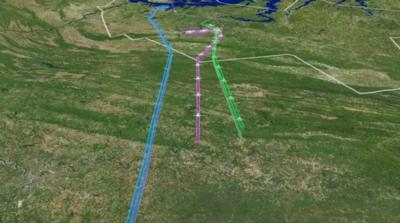Tue, Nov 25, 2014
Improvements Will Benefit Holiday Travelers, Agency Says
Just in time for the busy holiday travel season, the FAA announced that the Washington, D.C. Metroplex is the first in the nation to have three, state-of-the-art, satellite-based "highways in the sky" running side by side by side, each dedicated to one of the three major airports in the region.

“The national capital region is reaping the benefits of NextGen and this announcement further highlights how the federal government is making a difference,” said US Transportation Secretary Anthony Foxx. “These new and improved highways in the sky mean increased safety, more on time arrivals and departures, reduced fuel consumption, and reduced pollution-causing emissions.”
Estimates predict airlines will burn at least 2.5 million fewer gallons of fuel each year in the skies above Washington, while emitting at least 25,000 fewer metric tons of carbon dioxide. Using the Environmental Protection Agency’s energy calculator, this is the equivalent of annual greenhouse gas emissions from 5,263 passenger vehicles or 8,961 tons of waste taken to landfills.
“The whole point of NextGen is to get air travelers to their destinations safely and on time, and this is never more important than during the busy holiday season,” said FAA administrator Michael Huerta.
The three parallel Optimized Profile Descents (OPD) enable aircraft serving the capital area’s three major airports from the northwest to descend from cruising altitude to the runway in a smooth, continuous arc instead of the traditional staircase descent. This saves time for passengers, while reducing fuel and carbon dioxide emissions. A traditional staircase descent burns fuel at each step. In addition, voice communications between air traffic controllers and pilots are greatly reduced since clearances required during each step of a staircase descent are eliminated. The three airports benefitting from the NextGen arrivals are Baltimore/Washington International Thurgood Marshall Airport, Dulles International Airport and Ronald Reagan Washington National Airport.
The OPD into Baltimore/Washington opened this month, joining the existing OPDs into Dulles and National. Complementary, satellite-based departure paths are also being rolled out at the three airports, allowing aircraft to more quickly join high altitude traffic streams.
By improving traffic flow to the three major airports, the D.C. Metroplex initiative, a collaborative effort involving American, Southwest, United and labor unions, also enhances the safety and efficiency of flights serving Richmond International Airport, Andrews Joint Base Airport and at least nine smaller airports.
The number of flights through the holiday season is predicted to remain high at relatively the same levels as last year, but passenger counts are expected to be higher as airlines use larger aircraft capable of carrying more passengers. The number of flights Tuesday and Wednesday will be about 1.5 percent over a typical Tuesday and Wednesday. Saturday and Sunday will see a 15-18 percent increase in flights over a typical Saturday and Sunday.
The Department of Defense will again release to the FAA unused military airspace from Wednesday, Nov. 26, through Sunday, Nov. 30. The additional airspace allows the FAA to use routes otherwise unavailable to help relieve traffic congestion on the East Coast and throughout the Gulf of Mexico and the Southwest.
(Image from FAA video)
More News
The Industry Continues to be Rocked By Some Questionable Operations Recent investigations and a great deal of data has resulted in ANN’s SportPlane Resource Guide’s rep>[...]
Make Sure You NEVER Miss A New Story From Aero-News Network Do you ever feel like you never see posts from a certain person or page on Facebook or Instagram? Here’s how you c>[...]
Visual Approach Slope Indicator (VASI) An airport lighting facility providing vertical visual approach slope guidance to aircraft during approach to landing by radiating a directio>[...]
Airport Marking Aids Markings used on runway and taxiway surfaces to identify a specific runway, a runway threshold, a centerline, a hold line, etc. A runway should be marked in ac>[...]
Aero Linx: The Skyhawk Association The Skyhawk Association is a non-profit organization founded by former Skyhawk Pilots which is open to anyone with an affinity for the A-4 Skyhaw>[...]
 Unfortunate... ANN/SportPlane Resource Guide Adds To Cautionary Advisories
Unfortunate... ANN/SportPlane Resource Guide Adds To Cautionary Advisories ANN FAQ: Turn On Post Notifications
ANN FAQ: Turn On Post Notifications ANN's Daily Aero-Term (04.29.24): Visual Approach Slope Indicator (VASI)
ANN's Daily Aero-Term (04.29.24): Visual Approach Slope Indicator (VASI) ANN's Daily Aero-Term (04.28.24): Airport Marking Aids
ANN's Daily Aero-Term (04.28.24): Airport Marking Aids ANN's Daily Aero-Linx (04.28.24)
ANN's Daily Aero-Linx (04.28.24)



